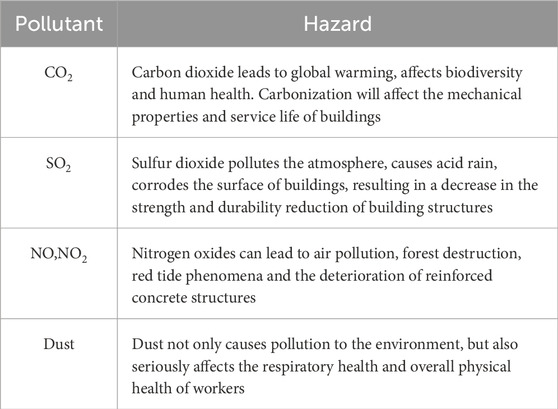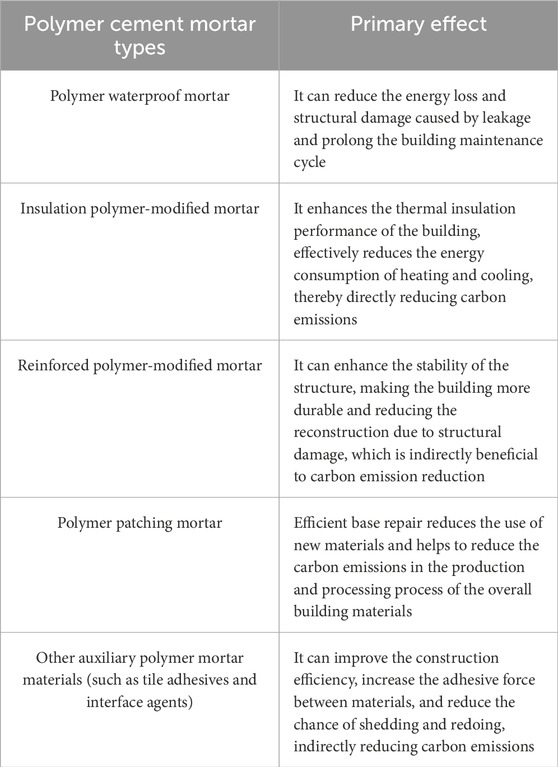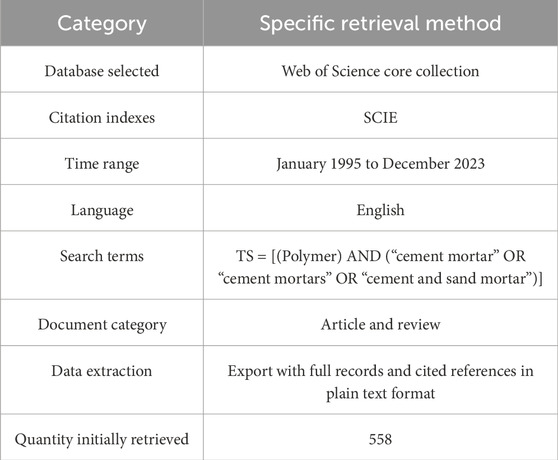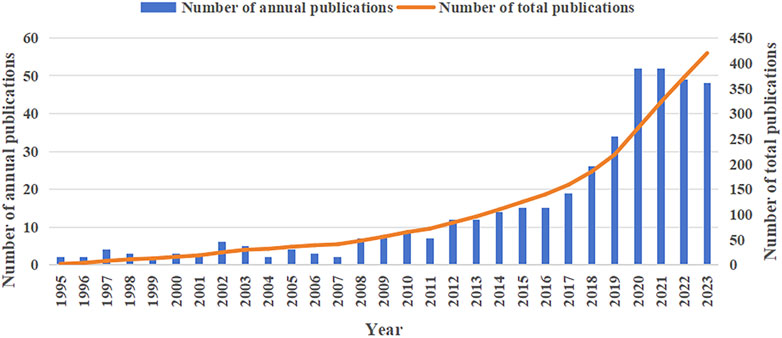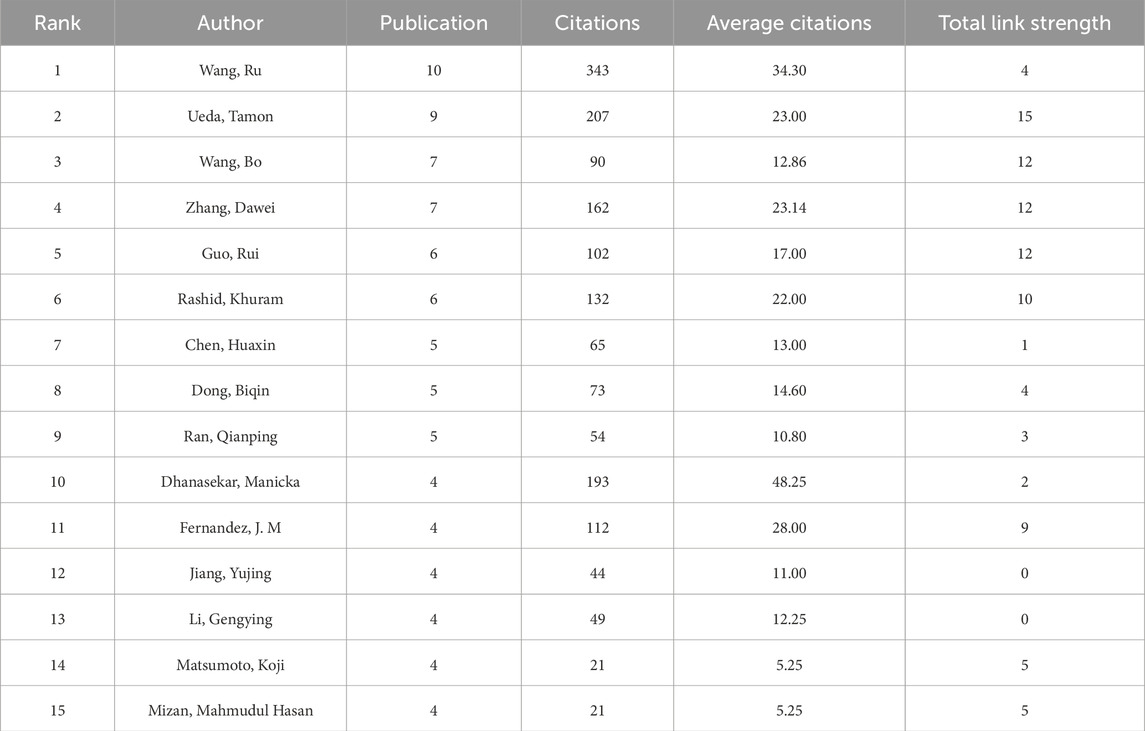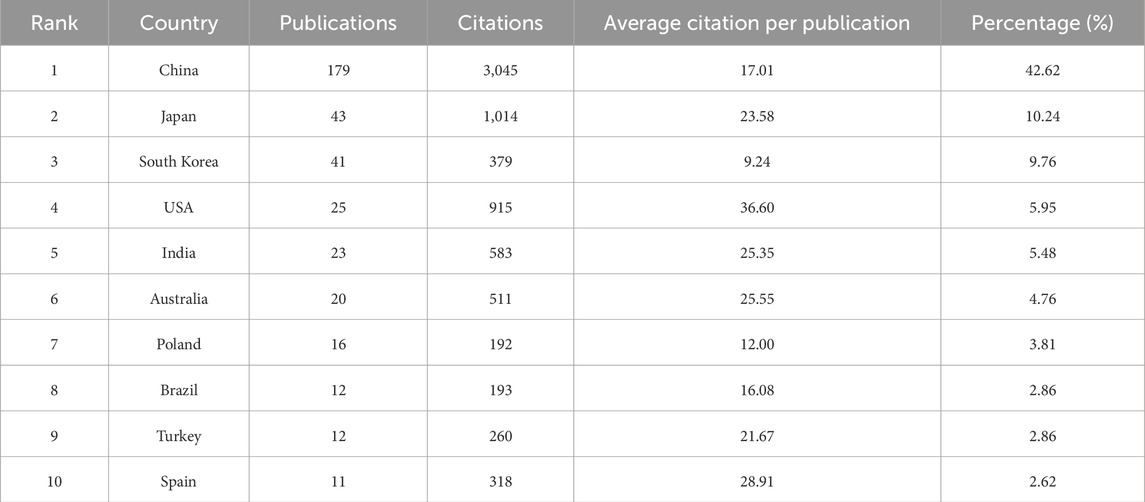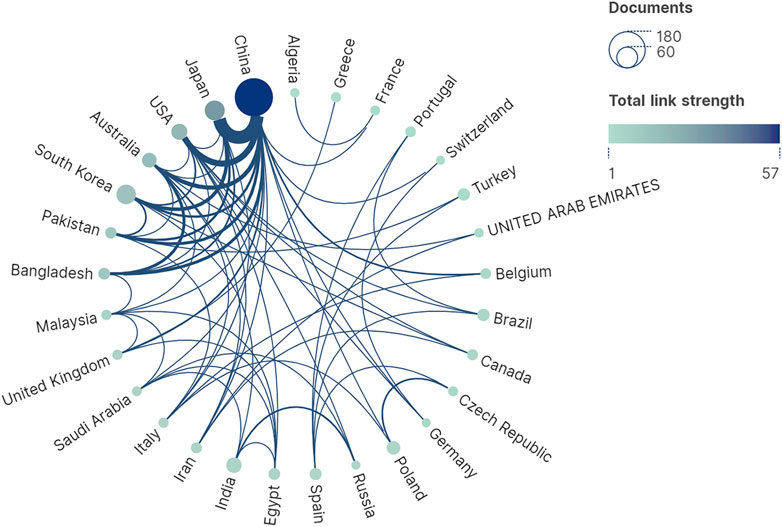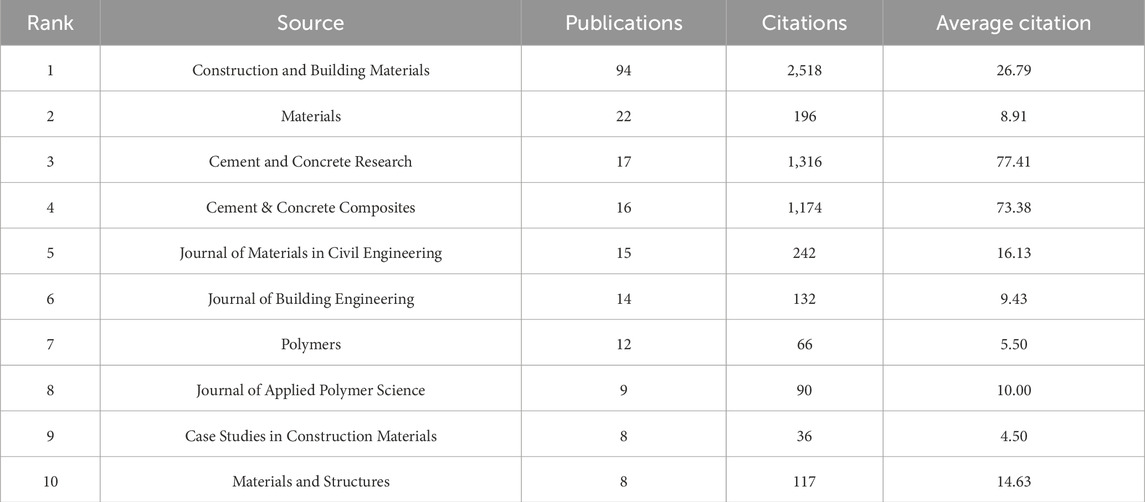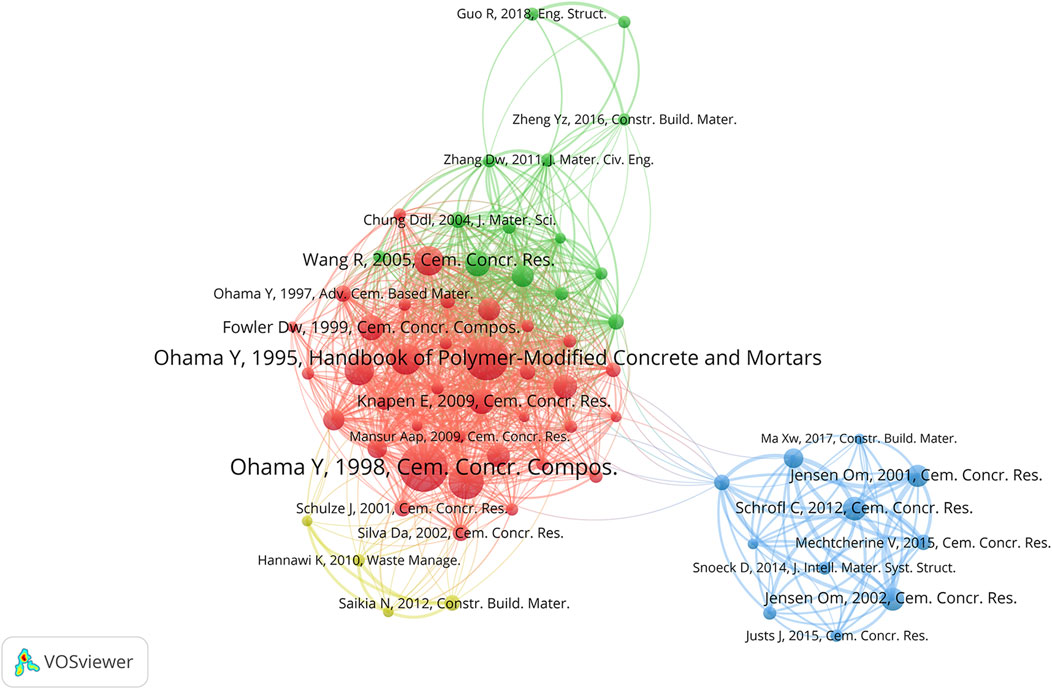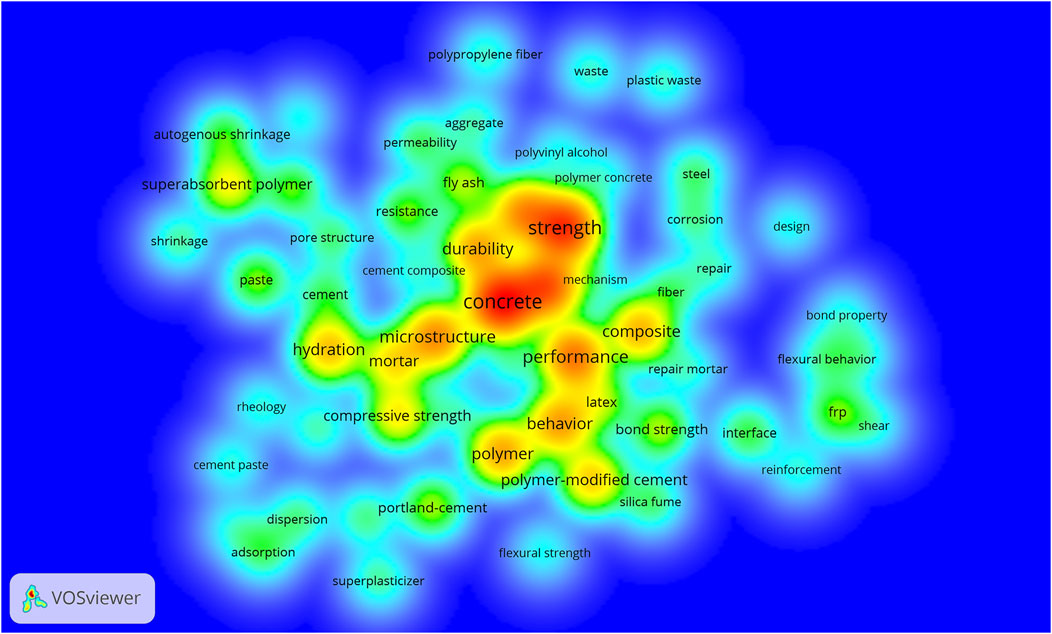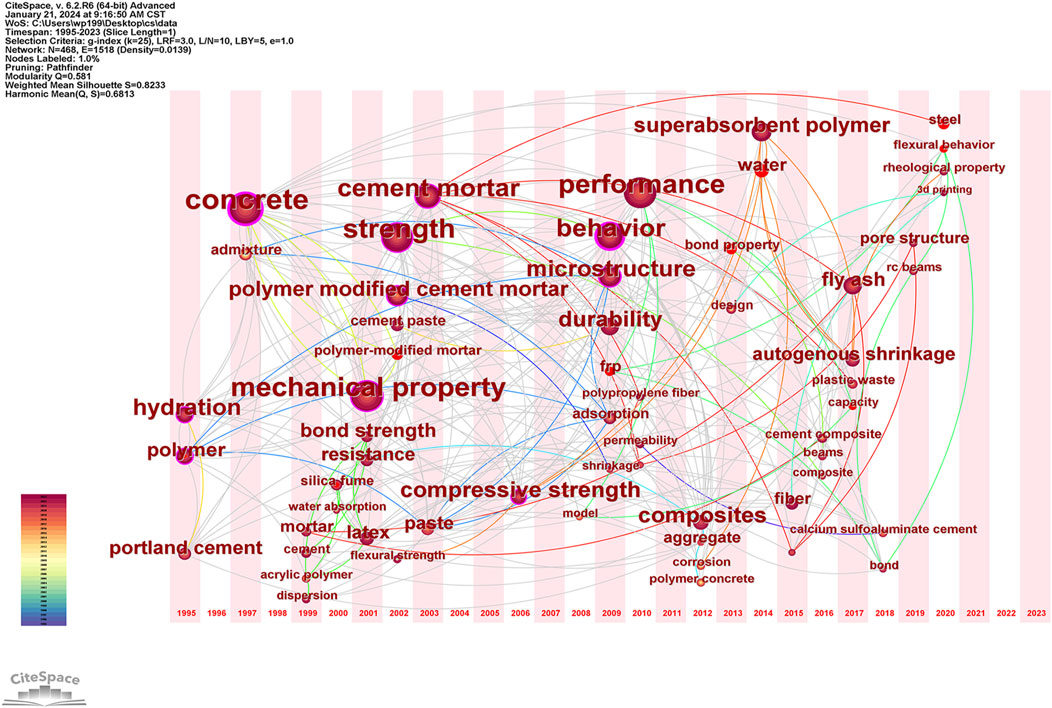- School of Applied Technology, Huanghe Science and Technology College, Zhengzhou, China
Ordinary cement mortar is commonly used in building engineering due to its high strength, affordability, and easy access to raw materials. However, it suffers from high shrinkage and poor impermeability, which result in reduced building service life and significant carbon dioxide emissions during production. Polymer additives have been found to enhance the mechanical properties of cement mortar, leading to increased interest in polymer cement mortar by researchers. This study collected and analyzed 420 papers published between 1995 and 2023 in the field of polymer cement mortar. The analysis included publication trends, author cooperation networks, national cooperation networks, published journals, co-citation of references, and keywords. The findings reveal a rapid publication growth from 2018 to 2023, with China making the most significant contribution in this field. Among the scholars, Ru Wang has published the highest number of articles in the field of polymer cement mortar, while Ohama’s papers have been cited the most. The journal with the most articles is Construction and Building Materials. Research in polymer cement mortar focuses on mechanical properties, performance, hydration process, microstructure, and other related aspects. The reinforcement effect of polymer-modified cement mortar on reinforced concrete and applying superabsorbent polymer-modified cement mortar and polymer fiber in cement mortar have emerged as recent research frontiers. This study can help scholars quickly identify high-quality references and research frontiers in the field of polymer cement mortar while also providing research directions and ideas.
1 Introduction
The Cement mortar is widely used in civil engineering. It is composed of cement, sand, water, and other raw materials, offering high strength, cost-effectiveness, and easy availability of resources (Qin et al., 2018; Peng et al., 2020). Its construction performance is commendable, facilitating efficient production (Shi et al., 2011; Luigi et al., 2018). However, ordinary cement mortar does have certain drawbacks. It exhibits significant shrinkage, making it susceptible to cracking and deformation, which can adversely affect the lifespan and appearance of buildings (Li et al., 2020). Additionally, ordinary cement mortar has poor impermeability and durability and is easily eroded by moisture, which leads to mortar falling off and damage (Liu et al., 2021; Qu et al., 2023). Moreover, cement production has a significant impact on the natural environmen. The global output of cement has risen from 1.39 billion tons in 1995 to 4.4 billion tons in 2021. This increase in production has resulted in substantial carbon dioxide emissions, with approximately 0.86 tons of carbon dioxide released per ton of cement produced. These carbon emissions contribute to around 5% of global carbon emissions yearly, significantly impacting climate change and environmental pollution (Monteiro et al., 2017; Belaïd, 2022; Singh et al., 2022; Hanifa et al., 2023). Table 1 shows the main pollutants emitted by ordinary cement mortar and their harms.
To mitigate carbon emissions from cement production and enhance the longevity of structures, it is imperative to enhance the fracture resistance and durability of cement mortar. With the development of chemical technology, people realize that the relaxation motion of macromolecular chain segments in polymers makes them show unique toughness, elasticity, and viscosity. Therefore, applying organic polymers with good flexibility, cohesiveness, tensile strength, impact resistance, and deformation properties to cement-based materials produces an interdisciplinary subject between polymer science and inorganic cementitious material chemistry. Mortar made of cement, fine aggregate, polymer, and the appropriate amount of water in a specific ratio is called polymer cement mortar, which can also be called polymer-modified cement mortar (Aggarwal et al., 2007; Kucharczyková et al., 2019). The production process of polymer cement mortar is similar to that of traditional cement mortar, involving four main steps: raw material selection, mix ratio determination, mixing, and curing. However, polymers may require pretreatment, leading to a more complex mixing process. The addition time and proportion of polymers must be carefully controlled. Specific curing and solidifying conditions may be necessary for certain polymer cement mortars. Table 2 presents the impact of various polymer cement mortars on reducing carbon emissions, categorized accordingly. The reduction in carbon emissions from different polymer cement mortars primarily arises from their capacity to enhance building material performance, thereby prolonging service life, lowering maintenance needs, and potentially decreasing energy consumption and emissions through alterations in the production process.
Polymer additives are commonly categorized into four groups: redispersible rubber powder, water-soluble polymer, polymer emulsions, and liquid polymer. However, liquid polymer is not widely utilized (Ohama, 1998). Examples of redispersible rubber powders include ethylene-vinyl acetate copolymer and vinyl acetate-ethylene-methyl methacrylate copolymer (Tarannum et al., 2020; Tarannum and Pooja, 2022; Balagopal et al., 2023). Water-soluble polymers, such as polyacrylic acid and polyacrylamide, are known for their water retention, thickening, retarding, drag reduction, and dispersion properties (Rai and Singh, 2005; Li et al., 2020). Polymer emulsions, like styrene-acrylate copolymer emulsion, can enhance the impermeability and durability of cement mortar (Yang et al., 2023).
As an organic and inorganic composite material, polymer cement mortar exhibits favorable properties. Adding polymer particles to cement mortar fills the holes, and the polymer film effectively seals them, enhancing the impermeability of the cement mortar. Furthermore, the polymer significantly enhances various characteristics of cement-based materials, including fluidity, water retention, durability, chemical corrosion resistance, freeze-thaw resistance, mechanical strength, and elongation (Chung, 2004; Eren et al., 2017; Kujawa et al., 2021; Zhang et al., 2021). The addition of super absorbent polymers to cement mortar in practical engineering applications can effectively repair cracks and enhance sulfate resistance (Afzal et al., 2016). Furthermore, polymer cement mortar has been successfully utilized in projects aimed at repairing historical masonry and enhancing resistance to salt erosion (Tc, 2012). After incorporating polymer materials into traditional cement mortar, initial construction costs may be higher. However, polymer cement mortar offers improved construction performance, durability, and mechanical properties. This can lead to a decrease in rework rates and maintenance costs during construction, as well as a reduction in long-term maintenance and repair expenses (Bozkurt and İslamoğlu, 2013). Consequently, engineering practitioners and researchers have increasingly focused on the potential of polymer cement mortar.
Scholars have extensively studied the research status of polymer cement mortar. Zhang et al. (2021) comprehensively analyzed the mechanical properties, microstructure, and polymer reinforcement mechanism of polymer cement mortar. Bahraq et al. (2022) utilized molecular simulation technology to investigate the interaction between polymers and cement. However, most documents focus on qualitative analyses of polymer cement mortar, which often involve subjective explanations. This approach can sometimes result in an overestimation or underestimation of the contribution of specific authors, either intentionally or unintentionally. To address this issue, conducting a quantitative study of a specific field using bibliometrics can objectively assess the field’s current state, research areas of interest, and development trends.
This study employed the bibliometrics method to quantitatively visualize the related literature of polymer cement mortar from 1995 to 2023. The research status, hotspots, and evolution trends in the field of polymer cement mortar were analyzed by constructing a knowledge map using visualization software. The paper is organized as follows: The second part summarizes the leading analysis methods, analysis tools, and data acquisition methods. The third part focuses on the output distribution and cooperation network, knowledge base, research topics, and frontier analysis of polymer cement mortar. Finally, the paper concludes with a discussion on the prospects of polymer cement mortar.
2 Data source and method
2.1 Method
Bibliometrics is an interdisciplinary science that uses mathematical and statistical methods to analyze various forms of knowledge quantitatively (Diem and Wolter, 2013). The concept of bibliometrics was formally introduced by Pritchard in 1969 and has since gained wide recognition in academic circles (Pritchard, 1969). During the analysis process, scholars can obtain detailed data on authors, keywords, periodical publications, countries, research institutions, and cited documents (Abramo et al., 2011). When selecting bibliometric analysis software, three core criteria should be considered: Firstly, the software should be able to extract critical information from the literature automatically. Secondly, it should be capable of conducting comprehensive and multi-dimensional analysis of the collected literature. Lastly, the software should have efficient data visualization functions to ensure a clear and intuitive presentation of the analysis results (Zhu et al., 2023).
Citespace and VOSviewer are widely used literature information visualization software (Pan et al., 2018). CiteSpace software is used to analyze research trends in a specific field and present them visually, allowing users to predict the field’s turning point and future development (Chen, 2006). VOSviewer software provides various visual views on authors, journals, countries, etc (van Eck and Waltman, 2010). Both software complement each other, resulting in more prosperous and comprehensive analysis results (Haghani, 2023). This study used VOSviewer and CiteSpace (version 6.2. R6) software to analyze data collected from the literature. The analysis includes authors, national cooperation relations, periodicals, research hotspots, and CiteSpace software, specifically used to study polymer cement mortar’s evolution path and research frontier.
2.2 Data source
To ensure the comprehensiveness and authority of the analyzed data, the Web of Science was employed as the primary source for this study (Thelwall, 2008). The data sources and retrieval methods are presented in Table 3. A total of 558 documents were retrieved using the methods described in the table. However, since the retrieved literature may not directly relate to the research theme, each was carefully screened before analysis. As a result, 420 valid documents were obtained, consisting of 408 research papers and 12 reviews.
3 Results and discussion
3.1 Yearly distribution and growth trends
The annual number of papers published in a particular discipline reflects the level of scientific research and the speed of development in this field to a certain extent. From 1995 to 2023, the published volume of polymer cement mortar is shown in Figure 1. The number of papers published in this field shows an overall growth trend. Based on the yearly increase in publications, the trend can be categorized into two distinct phases. The initial phase, spanning from 1995 to 2017, exhibits a sluggish growth pattern with an annual publication count remaining below 20. Remarkably, the peak of publications was observed in 2020 and 2021, with 52 articles. Subsequently, between 2018 and 2023, a rapid surge in published articles occurred, indicative of considerable academic interest and a subsequent phase of swift advancement in this research domain.
3.2 Document output distribution and cooperation network
3.2.1 Bibliometric analysis of the author
The author’s co-occurrence analysis aims to discuss the research and cooperation of polymer cement mortar, identify the key authors in this field and their collaboration relationships. Using VOSviewer software, authors who have published at least four articles were counted, and the results are presented in Table 4. From 1995 to 2023, a total of 1,475 authors were identified. Among them, the top four authors who published the most articles were Ru Wang, Tamon Ueda, Bo Wang, and Dawei Zhang, with 10, 9, 7, and 7 articles respectively. The most frequently cited authors were Ru Wang (343 citations), Tamon Ueda (207 citations), and Manicka Dhanasekar (193 citations). The authors with the highest average number of citations per article were Manicka Dhanasekar (48.25), Ru Wang (34.3), and J. M. Fernandez (28). Ru Wang excelled in the number of published papers, total citations, and average citations, making significant contributions to the research field of polymer cement mortar. Wang’s research primarily focuses on investigating the impact of various polymers on the properties of calcium sulfoaluminate cement (Li et al., 2018; Wang et al., 2021).
For the authors who have published at least three articles, the author’s cooperation network diagram is drawn by VOSviewer software, as shown in Figure 2. The three most apparent clusters in the figure represent the most critical cooperative research teams in polymer cement mortar. The first significant cluster is centered around Biqin Dong and consists of Xiangming Kong, Lin Li, Peiming Wang, Feng Xing, and Ru Wang. This cluster primarily focuses on studying the impact of different types of polymers on the properties of cement mortar (Li et al., 2020; Li et al., 2021). The second central cluster revolves around Bo Wang and includes Shinichi Hino, Lianheng Cai, Rui Guo, and Kimitaka Uji. Their research primarily investigates the reinforcement effect of fiber-reinforced polymer grids and polymer cement mortar on reinforced concrete beams (Guo et al., 2019; Wang et al., 2020). The third significant cluster centers around Tamon Ueda and comprises Mahmudul Hasan Mizan, Koji Matsumoto, Khuram Rashid, and Dawei Zhang. This cluster has the highest number of collaborations and mainly explores the bonding properties of polymer cement-based materials (Qian et al., 2016; Mizan et al., 2020).
In the cooperative network, the two authors with the most significant number of cooperators are Bo Wang and Tamon Ueda, with 7 and 5 cooperators, respectively. These authors actively collaborate with other scholars, which promotes the output of their papers and enhances the overall influence of their work. Based on the number of cooperative papers among authors, three significant cooperative relationships have been identified: Tamon Ueda-Dawei Zhang, Tamon Ueda-Khuram Rashid, and Koji Matsumoto-Mahmudul Hasan Mizan. The collaboration among these authors has formed meaningful cooperative relationships in the research of polymer cement mortar. The latest research on author cooperation has included a study by Tamon Ueda, Rashid, Khuram, and Dawei Zhang on the flexural bearing capacity of reinforced concrete beams with PCM cover layers in high-temperature environments. They introduced an average crack spacing method that takes into account crack spacing (Rashid et al., 2023). Additionally, recent research by (Hasan Mizan and Matsumoto, 2023) demonstrated that adding silica fume can enhance the bond strength between PCM and concrete, prolong the occurrence of debonding failure, and improve ductility.
3.2.2 Bibliometric analysis of the country
From 1995 to 2023, 52 countries conducted research in the field of polymer cement mortar. Table 5 presents the top 10 countries with the highest number of papers. Based on the paper output, China, Japan, and South Korea emerged as the leading countries, with 179, 43, and 41 papers, respectively. Notably, China’s publications account for 42.62% of the total, significantly surpassing other countries and establishing itself as the primary contributor in the field of polymer cement mortar. Additionally, Table 5 reveals a significant disparity in the distribution of countries, with a few nations dominating the research output. A regional analysis indicates that China, Japan, South Korea, and India published 293 articles, representing 68.1% of the total. This highlights the substantial contributions made by Asia to the study of polymer cement mortar. Moreover, the United States exhibits a remarkable citation count of 36.6, indicating a high academic standard in this field.
Using VOSviewer and Scimago Graphica software, the countries with more than three articles are visually analyzed, and the co-occurrence map of national cooperation is drawn as shown in Figure 3. Figure 3 displays the relationship between the number of published documents and the size of the round node. A larger round node indicates a higher number of published documents. Additionally, the strength of cooperation is represented by the connection line of the node. The thickness of the connection line indicates the frequency of cooperation between two countries. From the perspective of the number of cooperative relations, it is found that China has cooperative relations with 15 countries in the cooperative network, and its cooperation with other countries ranks first, indicating that China is the research center of polymer cement mortar at present, followed by the United States (11) and Australia (9).
From the analysis of the cooperation strength of countries, the top five cooperation relationships are China-Japan, China-United States, China-Australia, Japan-South Korea, and China-Pakistan. China has always been in a leading position in this field of cooperation. Its partners are mainly in Asia, North America, and Oceania, with relatively few cooperations with Europe. The countries with the highest cooperation relationships form the core bilateral relationships in international polymer cement mortar research.
3.2.3 Bibliometric analysis of the journal
Journals play a crucial role in disseminating research findings in polymer cement mortar. A comprehensive analysis of 420 papers using VOSviewer revealed that these papers were published across 131 journals. Table 6 presents the top ten journals in this research area. Construction and Building Materials, Materials, and Cement and Concrete Research emerged as the three leading journals, with 94, 22, and 17 articles, respectively. These journals also garnered significant citation numbers, with Construction and Building Materials receiving 2,518 citations, Materials receiving 196 citations, and Cement and Concrete Research receiving 1,316 citations. Construction and Building Materials stands out by publishing a considerably higher number of articles than other journals, indicating its popularity among experts in the field. This journal focuses on the study of building materials and their application technologies, covering topics such as cement, concrete reinforcement, bricks and mortar, additives, steel, polymers, and recycled materials. Research on polymer cement mortar is closely linked to these areas of study. As an open-access journal, Materials has substantially contributed to advancing this research area. Cement and Concrete Research and Cement & Concrete Composites boast the highest average citation numbers, exceeding 70. This suggests that articles published in these two journals are of exceptional quality, making them the top-tier journals in this domain. They primarily focus on research related to cement-based materials, energy-saving building materials, and various composite materials. Furthermore, these journals feature research outcomes concerning polymer cement-based materials as one of their critical focal points.
3.3 Co-citation analysis
By analyzing the co-cited literature in the field of polymer cement mortar, we can get a knowledge base in this field. The frequently cited documents are classic works or significant theoretical achievements in a particular field. Table 7 shows the five most cited documents.
Ohama has made significant contributions to the field of polymer cement mortar, and his research results are highly cited. His documents, namely, “Polymer-based Acknowledgements” and “Handbook of Polymer-Modified Concrete and Mortars: Properties and Process Technology,” have received 45 and 40 citations, respectively. In these two documents, he extensively studied the classification of polymers, the modification mechanism, simplified polymer models, and the properties of polymer cement mortar (Ohama, 1995; Ohama, 1998). These studies laid a strong foundation for subsequent research in this area. Many scholars refer to these two documents in their introductions. Aggarwal et al. (2007) researched the modification of cement mortar using epoxy and acrylic emulsions. They discovered the modified cement mortar exhibited high strength and excellent resistance to chloride ion and carbon dioxide penetration. Sakai and Sugita (1995) investigated the microstructure and compounding mechanism of polymer-modified cement mortar. Through cryo-SEM observations, they identified dispersed polymer particles and polymer films on the surface of PMC samples, thereby revealing the compounding mechanism of polymer-modified cement. This study provided a theoretical and experimental basis for applying polymer-modified cement. Wang et al. (2005) explored the modification of cement mortar using styrene-butadiene rubber emulsion. The study found that the apparent bulk density, compressive strength, and bending strength of polymer-modified mortar were influenced by the ratio of polymer to cement. Additionally, the study revealed the modification mechanism of polymer to cement mortar from a microstructural perspective. Overall, these five references primarily focus on polymer cement mortar’s performance, reaction mechanism, and microstructure.
Using VOSviewer software, a co-citation map of references was created with a threshold of 9. A total of 65 references with the highest co-citation times were selected to draw the map, as shown in Figure 4. The graph is divided into four clusters, represented by different colors. The red cluster primarily investigates the microstructure and reaction mechanism of polymer-modified cement mortar, examining the impact of various polymers on cement mortar properties (Barluenga and Hernández-Olivares, 2004; Wang et al., 2005; Aggarwal et al., 2007). The blue cluster focuses on the influence of superabsorbent polymers (SAP)on the shrinkage and strength of cement-based materials (Jensen and Hansen, 2001; 2002; Justs et al., 2015). The yellow cluster concentrates on applying waste plastics in cement mortar and concrete (Hannawi et al., 2010; Saikia and de Brito, 2012). Lastly, the green cluster centers on the research of polymer cement mortar for beam reinforcement (Zhang et al., 2011; Zheng et al., 2016; Guo et al., 2018).
3.4 Bibliometric analysis of keywords
Keywords play a crucial role in bibliometric analysis, as they provide insights into the research focus in the field of polymer cement mortar. A keyword density map was generated using VOSviewer software to identify the research hotspots in this field. Synonyms were merged, and only keywords with a co-occurrence frequency of 8 or more were considered. The keyword density view, depicted in Figure 5, illustrates the frequency of co-occurrence for each keyword. The brightness of the figure indicates a higher frequency of co-occurrence. The analysis reveals that keywords such as concrete, strength, mechanical property, performance, microstructure, cement mortar, behavior, polymer, durability, and hydration are representative terms in the polymer cement mortar field. Notably, the co-occurrence frequency of concrete is significantly higher (142 times) than other keywords. This can be attributed to the close relationship between concrete and mortar, as scholars focus on concrete’s strength, durability, and workability, which are closely tied to the study of cement mortar. Based on these high-frequency keywords, the research on polymer cement mortar can be categorized into two main areas: the investigation of mechanical properties in polymer-modified cement-based materials and the exploration of microstructure and hydration reactions in polymer cement mortar.
The mechanical properties of polymer-modified cement-based materials are the most concerning content of scholars, and the related research results are the most. High-frequency keywords such as concrete, strength, mechanical property, performance, and behavior show the critical contents of the study. When polymer is added to cement mortar, it often reduces compressive strength and improves the toughness. Adding ethyl acetate copolymer or styrene-butadiene rubber into cement mortar will increase porosity, hinder cement hydration, and lower compressive strength (Peng et al., 2020). Latex styrene-butadiene is added to cement mortar, the compressive strength of cement mortar decreases with the increase of the ratio of polymer to cement, and the bending strength of cement mortar increases when the ratio of polymer to cement is greater than or equal to 10% (Pascal et al., 2004). The toughness of epoxy resin emulsion-modified mortar is related to environmental temperature. The polymer mortar’s fracture energy and toughness increase with the decrease in test temperature (Reis et al., 2014). Polyvinyl alcohol fiber can reduce the shrinkage strain of cement mortar and the damage caused by it. It has remarkable ductility and energy absorption capacity and can enhance the toughness of cement mortar (Zanotti et al., 2014).
Alongside compressive strength, the bond strength of polymer cement mortar is also a crucial area of research. Currently, there is a greater focus in academic research on the bonding interaction between polymer cement mortar and concrete and bricks, with fewer studies addressing the interaction with steel, wood, and glass. The bonding effectiveness between polymer cement mortar and concrete is influenced by various factors such as temperature, humidity, and drying shrinkage. In environments with high temperature and humidity, the disparity in volume change between the materials can create tensile stress, leading to crack formation (Rashid et al., 2015). On the other hand, the bonding strength between polymer cement mortar and bricks is dependent on polymer content, water-binder ratio of the cement mortar, and aggregate content. Lower polymer content affects bonding strength based on water and aggregate amounts, while higher polymer content enhances bonding strength independently of aggregate quantity (Papaioannou et al., 2019).
High-frequency keywords such as microstructure, hydration, durability, pore structure, and permeability indicate that scholars pay great attention to the microstructure of polymer cement mortar and the hydration process of cement. Scholars study the interaction mechanism between polymer and cement mortar from the microscopic point of view and explore the reasons for enhancing the working performance and mechanical properties of polymer cement mortar. From a physical perspective, polymer particles can fill the pores after the polymer is added to cement mortar, and polymer particles will also form polymer films. The polymer films wrap cement paste and hydration products, which can improve the pore structure of composite mortar and show good impermeability in macro (Barluenga and Hernández-Olivares, 2004; Ramli and Akhavan Tabassi, 2012). The theoretical model of polymer film formation is mainly the Ohama model, and the distribution of polymer in cement mortar, the formation time of polymer film, and the lowest formation temperature of polymer film will all affect the film formation effect (Wang et al., 2016). From a chemical standpoint, functional groups in polymers such as hydroxyl, carboxyl, and ester groups will react chemically in cement paste, thus delaying the process of cement hydration. In the alkali-rich environment, the ester group of acrylate is hydrolyzed to form a carboxyl group, and the carboxyl group reacts with Ca(OH)2 to form a new product Ca(HCOO)2 (Wang et al., 2015). The ester functional groups of polymers can also absorb free and adsorbed calcium ions to form metal complexes (Ilango et al., 2021).
Durability is a critical performance factor of polymer cement mortar, encompassing erosion resistance, freeze-thaw resistance, and adaptability to high temperature and high humidity environments. Numerous studies have been conducted by scholars focusing on the durability of polymer cement mortar. (Bhattacharya et al., 1983). investigated the durability of polymer cement mortars in sulfuric acid and hydrochloric acid solutions, highlighting the significant impact of the interaction between cement and polymer on material durability. (Schulze and Killermann, 2001). examined the long-term performance of polymer modified mortar in both outdoor and indoor settings, noting that the polymer modified cement mortar maintained stable adhesion, flexural, and compressive strength over a 10-year period. The frost resistance of polymer cement mortar is influenced by the type of polymer used. Among the three polymers studied (styrene butadiene rubber (SBR), styrene acrylic ester (SAE), and polyacrylic ester (PAE)), only SBR has been shown to enhance the frost resistance and freeze-thaw cycle performance of sulphoaluminate cement mortar (Li et al., 2018). Research by (Knapen and Gemert, 2009) revealed that in high humidity conditions, water-soluble polymer films dissolve in water, leading to a significant decrease in the flexural strength of polymer cement mortar. Additionally, at elevated temperatures, the high temperature sensitivity of the polymer can cause the polymer film to degrade, resulting in a decline in the mechanical properties of the polymer cement mortar (Rashid et al., 2019). High-density polyethylene (HDPE) is incorporated into traditional mortar to enhance its thermal properties. The thermal conductivity of polymer cement mortar decreases with higher HDPE content. Additionally, the increase in HDPE content moderately impacts the specific heat capacity (Aattache et al., 2013). The polymer’s variety, dosage, and temperature will affect the polymer cement mortar’s durability.
Currently, SEM, EDS, XRD, and FTIR are the primary methods used to examine the microstructure of polymer cement mortar. SEM is particularly effective in studying the microstructure of cement mortar, allowing for detailed observation of sample morphology (Knapen and Van Gemert, 2011). EDS energy spectrum analysis is typically combined with SEM to conduct qualitative or semi-quantitative analysis of elements present on the surface or in micro-regions of cement mortar (Zhang et al., 2018). XRD is utilized for qualitative and quantitative analysis of hydration products in cement-based materials based on diffraction patterns. While specific crystal content cannot be directly determined, XRD can still provide insights into relative content and crystal characteristics (Ma et al., 2023). FTIR utilizes absorption spectral lines to analyze and determine the type and chemical composition of substances, offering quantitative insights into substance structure and relative content (Nodehi, 2021). When FTIR technology is used in conjunction with XRD or XPS to analyze hydration products in cement mortar, the results are highly effective.
In addition to the research mentioned above, Figure 5 demonstrates that Superabsorbent polymers (SAP) have received considerable attention from scholars. SAP is known for its unique ability to absorb water in humid environments and release it upon drying. This property facilitates the further hydration of unhydrated cement particles. Moreover, SAP exhibits expansibility, which means that when liquid enters a crack, SAP particles expand and effectively seal the crack, preventing any detrimental effects on the cement mortar caused by the invading fluid. Consequently, using SAP can enhance the cement hydration reaction within cracks, reduce cement mortar cracking, and improve its durability (Beushausen and Gillmer, 2014; Beushausen et al., 2014).
3.5 Analysis of evolution path and research frontiers
The burst term function in CiteSpace allows us to analyze the frequent appearance of keywords in a short period. This helps us identify research hotspots and development trends in polymer cement mortar. Table 8 presents the burst of keywords in the study of polymer cement mortar from 1995 to 2023. The keyword “polymer” has the earliest appearance and the longest burst time, lasting 20 years. The keyword “polymer-modified mortar” has the most robust burst strength (4.66) and a burst time from 2002 to 2012. Burst Terms such as “water” and “frp” burst from 2018 to 2021. Burst terms like “steel,” “flexible behavior,” and “bond property” have appeared in the last 4 years, indicating a recent focus on the influence of polymers on the flexural capacity and bond performance of reinforced concrete beams. Research has demonstrated that the use of carbon fiber reinforced polymer (CFRP) grids and sprayed polymer-cement-mortar (PCM) can enhance shear resistance, flexural stiffness, and ductility of reinforced concrete (RC) beams (Wang et al., 2020). Furthermore, reinforcing hollow slab beams with prestressed steel strands and polyurethane cement composite materials has been found to greatly improve flexural bearing capacity, crack resistance, and stiffness in experimental tests (Li et al., 2023).
To better understand the evolution of research on polymer cement mortar and identify emerging research hotspots, this study utilized the timezone view function in CiteSpace software to represent keyword trends visually. Only keywords with a frequency of at least five times were included to ensure clarity. Figure 6 displays the keyword timezone view, where the position of each node indicates the year of the keyword’s first appearance, and the node’s size represents the keyword’s cumulative frequency.
Based on the comprehensive analysis of Table 8 and Figure 6, the research content of polymer cement mortar from 1995 to 2023 can be categorized into four distinct phases. The first period is from 1995 to 2000, and the research of polymer cement mortar is in the initial exploration period, with the burst term polymer and the high-frequency keywords concrete, portland cement and hydration. During this period, although research on polymer cement mortar has been carried out, the focus of academic research is still on polymer and concrete. The second period is from 2001 to 2007, during which the mechanical properties of polymer cement mortar are mainly studied. Polymer-modified mortar, the burst term with the highest strength, appeared in 2002, showing that academic circles’ research focus has shifted to polymer cement mortar. Many high-frequency keywords related to mechanical properties have appeared, such as mechanical property, bond strength, compressive strength, and strength, indicating that the research on mechanical properties of polymer cement mortar has increased rapidly and continues. The third period is 2008-2017. At this stage, polymer cement mortar’s microstructure and pore characteristics are mainly studied. High-frequency keywords related to microstructure and pore, such as microstructure, pore structure, durability, autogenous shrinkage, and shrinkage, appear one after another. Scholars focus on polymer cement mortar’s durability, impermeability, and shrinkage. The fourth period is from 2018 to the present; research on polymer cement mortar has entered a stage of diversified development. During this period, key terms such as water, frp, steel, flexible behavior, and bond property have emerged. “water” is associated with superabsorbent polymer, while frp is linked to polymer fiber. Steel, flexible behavior, and bond properties are also relevant to reinforced concrete beams. In recent years, there has been a growing interest in the reinforcement effect of polymer-modified cement mortar on reinforced concrete, as well as the application of SAP-modified cement mortar and polymer fiber in cement mortar. Researchers have been exploring these areas as emerging research frontiers.
4 Prospect
In addition to polymer cement mortar, there are also ecological mortar and self-healing cement mortar, among other advanced materials used in buildings. Ecological mortar utilizes waste materials such as tailings, waste residues, and garbage in its production process to protect the environment. However, there are technical challenges in production, including unstable chemical composition and significant variability (Srivastava and Singh, 2020). Self-healing cement mortar offers self-repairing and regenerative properties, enhancing the durability and long-term stability of structures, although its technical maturity remains relatively low (Wu et al., 2012). In comparison, polymer cement mortar has been extensively researched, boasting mature theory, non-toxic and environmentally friendly products, and stable, high-performance characteristics, positioning it with more advantages for future development.
(1) Develop energy-saving and environment-friendly polymer cement mortar. The increasing global attention towards environmental protection and renewable resource utilization has made green polymer cement mortar a prominent area of research. Recycling waste rubber powder and plastic particles, decomposing and purifying them, and transforming them into pure recycled polymer can effectively promote material recycling and resource conservation (Feng et al., 2022).
(2) Determine the appropriate polymer as an admixture. Various polymers, such as solid particles, latex, anionic, cationic, and nonionic forms, can be used as additives. Price, toxicity, and ecological impact should be considered when selecting polymers, as they are crucial in limiting the widespread adoption of polymer bentonite-modified mortar. Therefore, future research should focus on selecting polymers based on engineering requirements.
(3) Developing compound polymer cement mortar is a promising avenue of research. Since each polymer has unique properties, combining multiple polymers can enhance their complementary effects. Additionally, incorporating industrial wastes like slag, fly ash, steel slag, and iron tailings can create a new composite modified cement mortar (Sun et al., 2021a; Sun et al., 2021b; Sun et al., 2022b). This approach improves working performance and promotes the circular economy by utilizing waste materials, reducing costs, and achieving ecological and environmental benefits.
(4) Application and cross-research of new technologies. Exploring the application and integration of new technologies, such as 3D printing and artificial intelligence with polymer cement mortar, offers exciting possibilities. For instance, image segmentation and recognition technology can analyze mortar’s internal pores and material composition. At the same time, machine learning can determine the optimal polymer types and dosage, predict mechanical properties, and research the potential of polymer cement mortar in 3D printing buildings (Sun et al., 2022a; Zhang et al., 2022; Tang et al., 2023).
(5) Polymer cement mortar, despite gaining attention for its exceptional performance in engineering applications, also encounters several challenges. Firstly, the availability of materials is crucial, requiring a focus on ensuring the quality and stable supply of raw materials such as polymers and cement. Secondly, in order to facilitate the seamless progression of polymer cement mortar from production to construction, it is imperative to conduct comprehensive education and training for the relevant construction personnel and professionals. This training should encompass various aspects including the production process, quality inspection, construction technology, troubleshooting, and ensuring safe production of polymer cement mortar Additionally, regulatory hurdles must not be overlooked, with construction entities needing to adhere to relevant industry standards to guarantee project quality. The polymers used in polymer cement mortar are typically water-based, designed to be non-toxic or low-toxic. Nonetheless, workers should adhere to appropriate safety regulations and wear personal protective equipment during operations to minimize potential health risks. Lastly, there is no globally unified standard for the utilization and control of polymers. In China, the recommended norms for the application of polymer cement mortar include Polymer Cement Waterproof Mortar (JG/T 336-2011), Polymer Cement Reinforcement Mortar (JC/T 2609-2021), and Polymer Cement Waterproof Mortar (JC/T 984-2005). Variations exist in standards across different countries and regions, necessitating strict adherence to local guidelines in experiments and engineering practices.
(6) At present, there is limited research available on the recycling and reuse of polymer cement mortar once it reaches the end of its service life. The recycling and utilization of materials play a crucial role in environmental impact and should be considered a significant research focus for the future. There is currently a lack of research on the complete life cycle of polymer cement mortar within the academic community. Conducting such research could significantly enhance the economic and social advantages of construction projects, ultimately leading to sustainable development.
5 Conclusion
This study employed bibliometric analysis to examine 420 articles published between 1995 and 2023 in the field of polymer cement mortar. The analysis utilized VOSviewer and CiteSpace software to identify the changing trend of publications, author distribution, national cooperation networks, and periodicals. Additionally, classical references in this field were identified through co-cited reference analysis. Finally, a keyword co-occurrence analysis was conducted to identify research hotspots and development trends in recent years systematically. The following conclusions were drawn:
(1) The research on polymer cement mortar has seen a steady increase, with a slow growth stage observed from 1995 to 2017, followed by a rapid growth stage from 2018 to 2023. Among the countries involved in this field, China has published the highest number of papers, accounting for 42.62% of the total publications, surpassing other countries by a significant margin. Ru Wang emerges as the most prolific scholar in terms of article publications, while Tamon Ueda stands out for his collaborations with other researchers. Construction and Building Materials is the leading journal regarding the number of articles published in this field. A co-cited reference analysis reveals that Ohama authored the two most influential documents. In these papers, Ohama extensively studied the classification of polymers, the modification mechanism and simplified model of polymers, as well as the properties of polymer cement mortar. These foundational studies have contributed significantly to subsequent research in the field.
(2) The research focus of polymer cement mortar is primarily on mechanical properties, performance, hydration process, and microstructure. Based on the frequency of keywords and relevant burst terms, the study on polymer cement mortar from 1995 to 2023 can be categorized into four distinct phases. The initial exploration period spans from 1995 to 2000. From 2001 to 2007, extensive investigations were conducted on the mechanical properties of polymer cement mortar. Between 2008 and 2017, the years witnessed a significant emphasis on studying the microstructure and pore characteristics of polymer cement mortar. Since 2018, research on polymer cement mortar has entered a stage characterized by diversified development. Notably, recent frontiers include exploring the strengthening effect of polymer-modified cement mortar on reinforced concrete and investigating SAP-modified cement mortar and the applications of polymer fiber in cement mortars.
While this study has made specific contributions, it is essential to acknowledge its limitations. Firstly, the study solely relies on the Web of Science core collection database and focuses only on English literature, which may not provide a comprehensive overview. In future research, including multiple databases to ensure a more comprehensive dataset would be beneficial. Additionally, engaging in active communication with scholars in this field can help gain a more objective understanding of the research content and enhance the overall quality and level of research.
Data availability statement
The original contributions presented in the study are included in the article/Supplementary Material, further inquiries can be directed to the corresponding author.
Author contributions
PW: Writing–original draft. FW: Writing–review and editing. MM: Writing–review and editing.
Funding
The author(s) declare that no financial support was received for the research, authorship, and/or publication of this article.
Acknowledgments
The authors thank Chengliang Wang of Zhejiang University of Technology.
Conflict of interest
The authors declare that the research was conducted in the absence of any commercial or financial relationships that could be construed as a potential conflict of interest.
Publisher’s note
All claims expressed in this article are solely those of the authors and do not necessarily represent those of their affiliated organizations, or those of the publisher, the editors and the reviewers. Any product that may be evaluated in this article, or claim that may be made by its manufacturer, is not guaranteed or endorsed by the publisher.
Supplementary material
The Supplementary Material for this article can be found online at: https://www.frontiersin.org/articles/10.3389/fmats.2024.1401816/full#supplementary-material
References
Aattache, A., Mahi, A., Soltani, R., Mouli, M., and Benosman, A. S. (2013). Experimental study on thermo-mechanical properties of polymer modified mortar. Mater. Des. 52, 459–469. doi:10.1016/j.matdes.2013.05.055
Abramo, G., D’Angelo, C. A., and Viel, F. (2011). The field-standardized average impact of national research systems compared to world average: the case of Italy. Scientometrics 88 (2), 599–615. doi:10.1007/s11192-011-0406-x
Afzal, A., Kausar, A., and Siddiq, M. (2016). Technical relevance of polymer/cement/carbon nanotube composite: opportunities and challenges. Polym.-Plast. Technol. Eng. 55 (16), 1743–1764. doi:10.1080/03602559.2016.1163608
Aggarwal, L. K., Thapliyal, P. C., and Karade, S. R. (2007). Properties of polymer-modified mortars using epoxy and acrylic emulsions. Constr. Build. Mater. 21 (2), 379–383. doi:10.1016/j.conbuildmat.2005.08.007
Bahraq, A. A., Al-Osta, M. A., Al-Amoudi, O. S. B., Saleh, T. A., and Obot, I. B. (2022). Atomistic simulation of polymer-cement interactions: progress and research challenges. Constr. Build. Mater. 327, 126881. doi:10.1016/j.conbuildmat.2022.126881
Balagopal, V., Raju, J. P., Kumar, A. A., Sajeev, M., and Veena, P. (2023). Effect of ethylene vinyl acetate on cement mortar – a review. Mater. Today. Proc. doi:10.1016/j.matpr.2023.03.692
Barluenga, G., and Hernández-Olivares, F. (2004). SBR latex modified mortar rheology and mechanical behaviour. Cem. Concr. Res. 34 (3), 527–535. doi:10.1016/j.cemconres.2003.09.006
Belaïd, F. (2022). How does concrete and cement industry transformation contribute to mitigating climate change challenges? Resour. Conserv. Recyl. Adv. 15, 200084. doi:10.1016/j.rcradv.2022.200084
Beushausen, H., and Gillmer, M. (2014). The use of superabsorbent polymers to reduce cracking of bonded mortar overlays. Cem. Concr. Compos. 52, 1–8. doi:10.1016/j.cemconcomp.2014.03.009
Beushausen, H., Gillmer, M., and Alexander, M. (2014). The influence of superabsorbent polymers on strength and durability properties of blended cement mortars. Cem. Concr. Compos. 52, 73–80. doi:10.1016/j.cemconcomp.2014.03.008
Bhattacharya, V. K., Kirtania, K. R., Maiti, M. M., and Maiti, S. (1983). Durability tests on polymer-cement mortar. Cem. Concr. Res. 13 (2), 287–290. doi:10.1016/0008-8846(83)90112-6
Bozkurt, O., and İslamoğlu, M. (2013). Comparison of cement-based and polymer-based concrete pipes for analysis of cost assessment. Int. J. Polym. Sci. 2013, 1–6. doi:10.1155/2013/921076
Chen, C. (2006). CiteSpace II: detecting and visualizing emerging trends and transient patterns in scientific literature. J. Am. Soc. Inf. Sci. Tec. 57 (3), 359–377. doi:10.1002/asi.20317
Chung, D. D. L. (2004). Use of polymers for cement-based structural materials. J. Mater. Sci. 39 (9), 2973–2978. doi:10.1023/B:JMSC.0000025822.72755.70
Diem, A., and Wolter, S. C. (2013). The use of bibliometrics to measure research performance in education sciences. Res. High. Educ. 54 (1), 86–114. doi:10.1007/s11162-012-9264-5
Eren, F., Gödek, E., Keskinateş, M., Tosun-Felekoğlu, K., and Felekoğlu, B. (2017). Effects of latex modification on fresh state consistency, short term strength and long term transport properties of cement mortars. Constr. Build. Mater. 133, 226–233. doi:10.1016/j.conbuildmat.2016.12.080
Feng, W. H., Wang, Y. F., Sun, J. B., Tang, Y. C., Wu, D. X., Jiang, Z. W., et al. (2022). Prediction of thermo-mechanical properties of rubber-modified recycled aggregate concrete. Constr. Build. Mater. 318, 125970. doi:10.1016/j.conbuildmat.2021.125970
Guo, R., Cai, L. H., Hino, S. C., and Wang, B. (2019). Experimental study on shear strengthening of RC beams with an FRP grid-PCM reinforcement layer. Appl. Sci.-Basel 9 (15), 2984. doi:10.3390/app9152984
Guo, R., Pan, Y., Cai, L., and Hino, S. (2018). Study on design formula of shear capacity of RC beams reinforced by CFRP grid with PCM shotcrete method. Eng. Struct. 166, 427–440. doi:10.1016/j.engstruct.2018.03.095
Haghani, M. (2023). What makes an informative and publication-worthy scientometric analysis of literature: a guide for authors, reviewers and editors. Transp. Res. Interdiscip. Perspect. 22, 100956. doi:10.1016/j.trip.2023.100956
Hanifa, M., Agarwal, R., Sharma, U., Thapliyal, P., and Singh, L. (2023). A review on CO2 capture and sequestration in the construction industry: emerging approaches and commercialised technologies. J. CO2 Util. 67, 102292. doi:10.1016/j.jcou.2022.102292
Hannawi, K., Kamali-Bernard, S., and Prince, W. (2010). Physical and mechanical properties of mortars containing PET and PC waste aggregates. Waste Manag. 30 (11), 2312–2320. doi:10.1016/j.wasman.2010.03.028
Hasan Mizan, M., and Matsumoto, K. (2023). Polymer cement mortar strengthened RC beams with/without silica fume as repair material. Constr. Build. Mater. 409, 134046. doi:10.1016/j.conbuildmat.2023.134046
Ilango, N. K., Gujar, P., Nagesh, A. K., Alex, A., and Ghosh, P. (2021). Interfacial adhesion mechanism between organic polymer coating and hydrating cement paste. Cem. Concr. Compos. 115, 103856. doi:10.1016/j.cemconcomp.2020.103856
Jensen, O. M., and Hansen, P. F. (2001). Water-entrained cement-based materials: I. Principles and theoretical background. Cem. Concr. Res. 31 (4), 647–654. doi:10.1016/S0008-8846(01)00463-X
Jensen, O. M., and Hansen, P. F. (2002). Water-entrained cement-based materials: II. Experimental observations. Cem. Concr. Res. 32 (6), 973–978. doi:10.1016/S0008-8846(02)00737-8
Justs, J., Wyrzykowski, M., Bajare, D., and Lura, P. (2015). Internal curing by superabsorbent polymers in ultra-high performance concrete. Cem. Concr. Res. 76, 82–90. doi:10.1016/j.cemconres.2015.05.005
Knapen, E., and Gemert, D. V. (2009). Effect of under water storage on bridge formation by water-soluble polymers in cement mortars. Constr. Build. Mater. 23 (11), 3420–3425. doi:10.1016/j.conbuildmat.2009.06.007
Knapen, E., and Van Gemert, D. (2011). Microstructural analysis of paste and interfacial transition zone in cement mortars modified with water-soluble polymers. Key Eng. Mater. 466, 21–28. doi:10.4028/www.scientific.net/KEM.466.21
Kucharczyková, B., Šimonová, H., Halamová, R., Kocáb, D., and Alexa, M. (2019). Experimental analysis focused on the material characteristics of the cement-based polymer-modified mortars. Acta Polytech. CTU Proc. 22, 52–56. doi:10.14311/APP.2019.22.0052
Kujawa, W., Olewnik-Kruszkowska, E., and Nowaczyk, J. (2021). Concrete strengthening by introducing polymer-based additives into the cement matrix-A mini review. Mater. (Basel) 14 (20), 6071. doi:10.3390/ma14206071
Li, H. X., Ni, D. Y., Li, L., Dong, B. Q., Chen, Q., and Gu, L. N. (2020). Insight into the role of polyacrylamide polymer powder on the cracking in plastic period of cement mortar. Constr. Build. Mater. 260, 119914. doi:10.1016/j.conbuildmat.2020.119914
Li, H. X., Ni, D. Y., Liang, G. W., Guo, Y. C., and Dong, B. Q. (2021). Mechanical performance and microstructure of cement paste/mortar modified by VAEC dispersible powder cured under different temperatures. Constr. Build. Mater. 278, 122446. doi:10.1016/j.conbuildmat.2021.122446
Li, J., Cui, Y., Xiong, D., Lu, Z., Dong, X., Zhang, H., et al. (2023). Experimental study on the bending resistance of hollow slab beams strengthened with prestressed steel strand polyurethane cement composite. Coatings 13 (2), 458. doi:10.3390/coatings13020458
Li, L., Wang, R., and Lu, Q. Y. (2018). Influence of polymer latex on the setting time, mechanical properties and durability of calcium sulfoaluminate cement mortar. Constr. Build. Mater. 169, 911–922. doi:10.1016/j.conbuildmat.2018.03.005
Liu, C., Huang, X., Wu, Y.-Y., Deng, X., and Zheng, Z. (2021). The effect of graphene oxide on the mechanical properties, impermeability and corrosion resistance of cement mortar containing mineral admixtures. Constr. Build. Mater. 288, 123059. doi:10.1016/j.conbuildmat.2021.123059
Luigi, C., Tiziano, B., Alberto, B., Bignozzi, M. C., Fabio, B., Andrea, B., et al. (2018). Binders alternative to Portland cement and waste management for sustainable construction–Part 2. J. Appl. Biomater. Funct. Mater. 16 (4), 207–221. doi:10.1177/2280800018782852
Ma, H., Wang, R., Xi, Z., Gao, H., Fryda, H., and Wang, P. (2023). Regulation and inhibition of early whitening of calcium aluminate cement/hemihydrate gypsum decorative mortar by polymer emulsion. Constr. Build. Mater. 393, 132023. doi:10.1016/j.conbuildmat.2023.132023
Mizan, M. H., Ueda, T., and Matsumoto, K. (2020). Enhancement of the concrete-PCM interfacial bonding strength using silica fume. Constr. Build. Mater. 259, 119774. doi:10.1016/j.conbuildmat.2020.119774
Monteiro, P. J. M., Miller, S. A., and Horvath, A. (2017). Towards sustainable concrete. Nat. Mater. 16 (7), 698–699. doi:10.1038/nmat4930
Nodehi, M. (2021). Epoxy, polyester and vinyl ester based polymer concrete: a review. Innov. Iinfrastruct. So. 7 (1), 64. doi:10.1007/s41062-021-00661-3
Ohama, Y. (1995). Handbook of polymer-modified concrete and mortars: properties and process technology. New Jersey, NJ: Noyes.
Ohama, Y. (1998). Polymer-based admixtures. Cem. Concr. Compos. 20 (2-3), 189–212. doi:10.1016/s0958-9465(97)00065-6
Pan, X., Yan, E., Cui, M., and Hua, W. (2018). Examining the usage, citation, and diffusion patterns of bibliometric mapping software: a comparative study of three tools. J. Informetr. 12 (2), 481–493. doi:10.1016/j.joi.2018.03.005
Papaioannou, S., Argyropoulou, R., Kalogiannidou, C., Melidis, G., Papadopoulou, L., Evelzaman, I., et al. (2019). Mechanical and adhesion properties of polymer-modified cement mortars in relation with their microstructure. J. Adhes. 95 (2), 126–145. doi:10.1080/00218464.2017.1406348
Pascal, S., Alliche, A., and Pilvin, P. (2004). Mechanical behaviour of polymer modified mortars. Mater. Sci. Eng. A 380 (1), 1–8. doi:10.1016/j.msea.2004.03.049
Peng, Y., Zhao, G. R., Qi, Y. X., and Zeng, Q. (2020). In-situ assessment of the water-penetration resistance of polymer modified cement mortars by μ-XCT, SEM and EDS. Cem. Concr. Compos. 114, 103821. doi:10.1016/j.cemconcomp.2020.103821
Qian, Y., Zhang, D. W., and Ueda, T. (2016). Interfacial tensile bond between substrate concrete and repairing mortar under freeze-thaw cycles. J. Adv. Concr. Technol. 14 (8), 421–432. doi:10.3151/jact.14.421
Qin, L., Gao, X., and Li, Q. (2018). Upcycling carbon dioxide to improve mechanical strength of Portland cement. J. Clean. Prod. 196, 726–738. doi:10.1016/j.jclepro.2018.06.120
Qu, L., Song, W., Wang, Q., Xu, S., and Hou, C. (2023). Effects of hydrophobic modified fly ash on resistance of chloride corrosion and water penetration of cement mortar in the early hydration stage. J. Build. Eng. 64, 105573. doi:10.1016/j.jobe.2022.105573
Rai, U. S., and Singh, R. K. (2005). Effect of polyacrylamide on the different properties of cement and mortar. Mater. Sci. Eng. A 392 (1), 42–50. doi:10.1016/j.msea.2004.08.050
Ramli, M., and Akhavan Tabassi, A. (2012). Effects of polymer modification on the permeability of cement mortars under different curing conditions: a correlational study that includes pore distributions, water absorption and compressive strength. Constr. Build. Mater. 28 (1), 561–570. doi:10.1016/j.conbuildmat.2011.09.004
Rashid, K., Ju, M., Ueda, T., and Zhang, D. (2023). Crack spacing-based flexural capacity of polymer cement mortar overlay reinforced concrete beams at high environmental temperature. ACI Struct. J. 120. doi:10.14359/51738749
Rashid, K., Ueda, T., Zhang, D., Miyaguchi, K., and Nakai, H. (2015). Experimental and analytical investigations on the behavior of interface between concrete and polymer cement mortar under hygrothermal conditions. Constr. Build. Mater. 94, 414–425. doi:10.1016/j.conbuildmat.2015.07.035
Rashid, K., Wang, Y., and Ueda, T. (2019). Influence of continuous and cyclic temperature durations on the performance of polymer cement mortar and its composite with concrete. Compos. Struct. 215, 214–225. doi:10.1016/j.compstruct.2019.02.057
Reis, J. M. L., Carvalho, A. R., and da Costa Mattos, H. S. (2014). Effects of displacement rate and temperature on the fracture properties of polymer mortars. Constr. Build. Mater. 55, 1–4. doi:10.1016/j.conbuildmat.2014.01.017
Saikia, N., and de Brito, J. (2012). Use of plastic waste as aggregate in cement mortar and concrete preparation: a review. Constr. Build. Mater. 34, 385–401. doi:10.1016/j.conbuildmat.2012.02.066
Sakai, E., and Sugita, J. (1995). Composite mechanism of polymer modified cement. Cem. Concr. Res. 25 (1), 127–135. doi:10.1016/0008-8846(94)00120-N
Schulze, J., and Killermann, O. (2001). Long-term performance of redispersible powders in mortars. Cem. Concr. Res. 31 (3), 357–362. doi:10.1016/S0008-8846(00)00498-1
Shi, C., Jiménez, A. F., and Palomo, A. (2011). New cements for the 21st century: the pursuit of an alternative to Portland cement. Cem. Concr. Res. 41 (7), 750–763. doi:10.1016/j.cemconres.2011.03.016
Singh, N., Sharma, B., and Rathee, M. (2022). Carbonation resistance of blended mortars and industrial by-products: a brief review. Clean. Mater. 4, 100058. doi:10.1016/j.clema.2022.100058
Srivastava, A., and Singh, S. K. (2020). Utilization of alternative sand for preparation of sustainable mortar: a review. J. Clean. Prod. 253, 119706. doi:10.1016/j.jclepro.2019.119706
Sun, J. B., Ma, Y. Z., Li, J. X., Zhang, J. F., Ren, Z. H., and Wang, X. Y. (2021a). Machine learning-aided design and prediction of cementitious composites containing graphite and slag powder. J. Build. Eng. 43, 102544. doi:10.1016/j.jobe.2021.102544
Sun, J. B., Wang, J. Q., Zhu, Z. Y., He, R., Peng, C., Zhang, C., et al. (2022a). Mechanical performance prediction for sustainable high-strength concrete using bio-inspired neural network. Buildings-Basel 12 (1), 65. doi:10.3390/buildings12010065
Sun, J. B., Wang, X. Y., Zhang, J. F., Xiao, F., Sun, Y. T., Ren, Z. H., et al. (2021b). Multi-objective optimisation of a graphite-slag conductive composite applying a BAS-SVR based model. J. Build. Eng. 44, 103223. doi:10.1016/j.jobe.2021.103223
Sun, J. B., Wang, Y. F., Li, K. F., Yao, X. P., Zhu, B. R., Wang, J. Q., et al. (2022b). Molecular interfacial properties and engineering performance of conductive fillers in cementitious composites. J. Mater. Res. Technol-JMRT 19, 591–604. doi:10.1016/j.jmrt.2022.05.061
Tang, Y. C., Huang, Z. F., Chen, Z., Chen, M. Y., Zhou, H., Zhang, H. X., et al. (2023). Novel visual crack width measurement based on backbone double-scale features for improved detection automation. Eng. Struct. 274, 115158. doi:10.1016/j.engstruct.2022.115158
Tarannum, N., and Pooja, K. (2022). Recent trends and applications in the research and development activities of redispersible powder: a vision of twenty-first century. Polym. Bull. 79 (10), 8093–8142. doi:10.1007/s00289-021-03928-y
Tarannum, N., Pooja, K., and Khan, R. (2020). Preparation and applications of hydrophobic multicomponent based redispersible polymer powder: a review. Constr. Build. Mater. 247, 118579. doi:10.1016/j.conbuildmat.2020.118579
Tc, R. H. M. (2012). RILEM TC 203-RHM: repair mortars for historic masonry. Mater. Struct. 45 (9), 1295–1302. doi:10.1617/s11527-012-9917-z
Thelwall, M. (2008). Bibliometrics to webometrics. J. Inf. Sci. 34 (4), 605–621. doi:10.1177/0165551507087238
van Eck, N. J., and Waltman, L. (2010). Software survey: VOSviewer, a computer program for bibliometric mapping. Scientometrics 84 (2), 523–538. doi:10.1007/s11192-009-0146-3
Wang, B., Wang, Z. P., Uji, K., Zhang, J. L., and Guo, R. (2020). Experimental investigation on shear behavior of RC beams strengthened by CFRP grids and PCM. Structures 27, 1994–2010. doi:10.1016/j.istruc.2020.07.050
Wang, M., Wang, R., Zheng, S., Farhan, S., Yao, H., and Jiang, H. (2015). Research on the chemical mechanism in the polyacrylate latex modified cement system. Cem. Concr. Res. 76, 62–69. doi:10.1016/j.cemconres.2015.05.008
Wang, R., Fan, Y. S., Wang, Z. J., Huang, T. Y., and Zhang, T. (2021). Performance development of styrene-butadiene copolymer-modified calcium sulfoaluminate cement mortar under different curing conditions. J. Zhejiang Univ.-SCI A 22 (12), 1005–1026. doi:10.1631/jzus.A2000526
Wang, R., Li, J., Zhang, T., and Czarnecki, L. (2016). Chemical interaction between polymer and cement in polymer-cement concrete. Bull. Pol. Acad. Sci. Tech. Sci. 64 (4), 785–792. doi:10.1515/bpasts-2016-0087
Wang, R., Wang, P.-M., and Li, X.-G. (2005). Physical and mechanical properties of styrene–butadiene rubber emulsion modified cement mortars. Cem. Concr. Res. 35 (5), 900–906. doi:10.1016/j.cemconres.2004.07.012
Wu, M., Johannesson, B., and Geiker, M. (2012). A review: self-healing in cementitious materials and engineered cementitious composite as a self-healing material. Constr. Build. Mater. 28 (1), 571–583. doi:10.1016/j.conbuildmat.2011.08.086
Yang, J., Wang, J. F., He, X. Y., Yu, X. L., Su, Y., Huang, J. X., et al. (2023). Sodium oleate and styrene-acrylate copolymer emulsion-modified cement mortar: functional combination of physical barrier and hydrophobicity. J. Mater. Civ. Eng. 35 (8), 13. doi:10.1061/jmcee7.Mteng-15557
Zanotti, C., Banthia, N., and Plizzari, G. (2014). A study of some factors affecting bond in cementitious fiber reinforced repairs. Cem. Concr. Res. 63, 117–126. doi:10.1016/j.cemconres.2014.05.008
Zhang, B., Tan, H., Shen, W., Xu, G., Ma, B., and Ji, X. (2018). Nano-silica and silica fume modified cement mortar used as Surface Protection Material to enhance the impermeability. Cem. Concr. Compos. 92, 7–17. doi:10.1016/j.cemconcomp.2018.05.012
Zhang, D., Ueda, T., and Furuuchi, H. (2011). Intermediate crack debonding of polymer cement mortar overlay-strengthened RC beam. J. Mater. Civ. Eng. 23 (6), 857–865. doi:10.1061/(asce)mt.1943-5533.0000240
Zhang, J. F., Sun, Y. T., Li, G. C., Wang, Y. H., Sun, J. B., and Li, J. X. (2022). Machine-learning-assisted shear strength prediction of reinforced concrete beams with and without stirrups. Eng. Comput. 38 (2), 1293–1307. doi:10.1007/s00366-020-01076-x
Zhang, X. J., Du, M. R., Fang, H. Y., Shi, M. S., Zhang, C., and Wang, F. M. (2021). Polymer-modified cement mortars: their enhanced properties, applications, prospects, and challenges. Constr. Build. Mater. 299, 124290. doi:10.1016/j.conbuildmat.2021.124290
Zheng, Y.-Z., Wang, W.-W., and Brigham, J. C. (2016). Flexural behaviour of reinforced concrete beams strengthened with a composite reinforcement layer: BFRP grid and ECC. Constr. Build. Mater. 115, 424–437. doi:10.1016/j.conbuildmat.2016.04.038
Keywords: polymer cement mortar, bibliometric analysis, CiteSpace, VOSviewer, hotspot analysis
Citation: Wang P, Wang F and Ma M (2024) The research progress and Hotspot analysis of polymer cement mortar based on bibliometrics. Front. Mater. 11:1401816. doi: 10.3389/fmats.2024.1401816
Received: 16 March 2024; Accepted: 23 August 2024;
Published: 03 September 2024.
Edited by:
Pervez Alam, Baba Ghulam Shah Badshah University, IndiaReviewed by:
José Cleiton Sousa dos Santos, University of International Integration of Afro-Brazilian Lusophony, BrazilYaoguang Guo, Shanghai Polytechnic University, China
Copyright © 2024 Wang, Wang and Ma. This is an open-access article distributed under the terms of the Creative Commons Attribution License (CC BY). The use, distribution or reproduction in other forums is permitted, provided the original author(s) and the copyright owner(s) are credited and that the original publication in this journal is cited, in accordance with accepted academic practice. No use, distribution or reproduction is permitted which does not comply with these terms.
*Correspondence: Peng Wang, aGtkd2FuZ3BlbmdAMTYzLmNvbQ==
 Peng Wang
Peng Wang Fei Wang
Fei Wang Mingquan Ma
Mingquan Ma